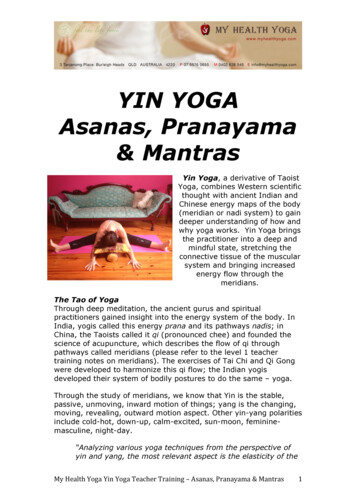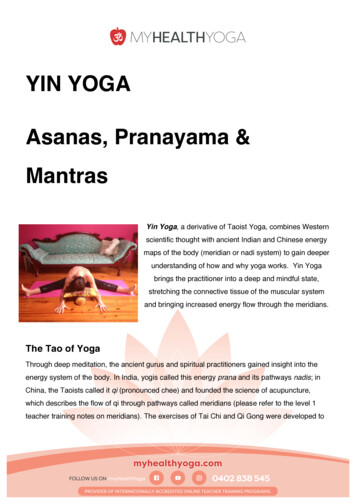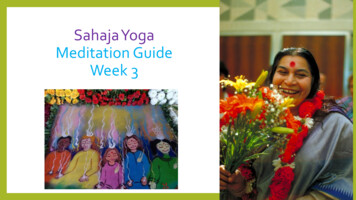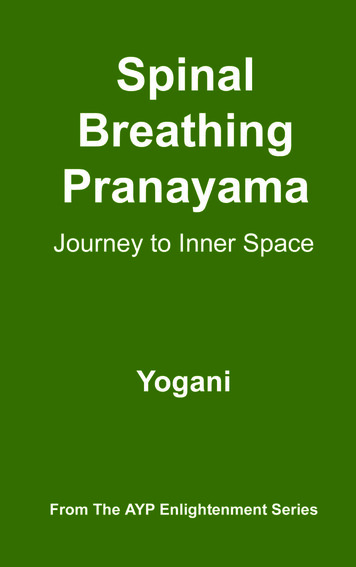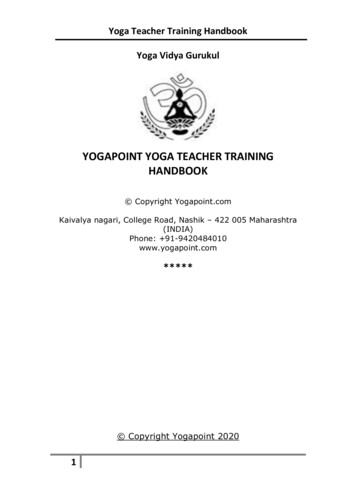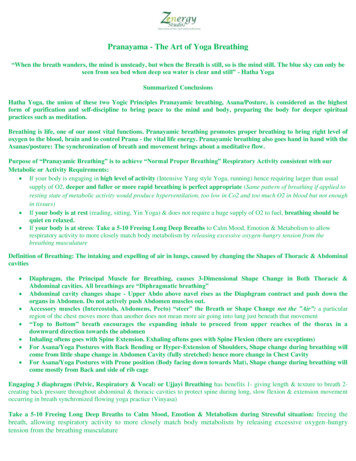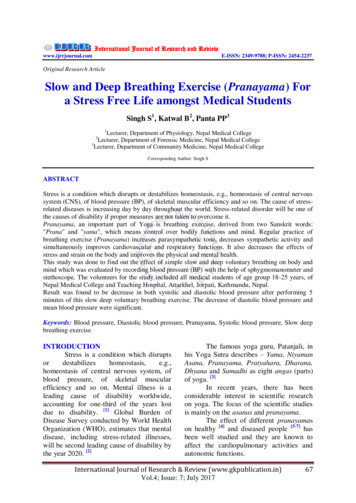
Transcription
Australian Journal of Teacher EducationVolume 42 Issue 9Article 92017Pranayama Meditation (Yoga Breathing) for StressRelief: Is it Beneficial for Teachers?Stevie-Jae HepburnThe University of Queensland, Australia, s.hepburn@uq.edu.auMary McMahonThe University of Queensland, marylmcmahon@uq.edu.auRecommended CitationHepburn, S., & McMahon, M. (2017). Pranayama Meditation (Yoga Breathing) for Stress Relief: Is it Beneficial for Teachers?.Australian Journal of Teacher Education, his Journal Article is posted at Research Online.http://ro.ecu.edu.au/ajte/vol42/iss9/9
Australian Journal of Teacher EducationPranayama Meditation (Yoga Breathing) for Stress Relief: Is it Beneficialfor Teachers?Stevie-Jae HepburnMary McMahonThe University of QueenslandAbstract: The effects of stress can have a significant impact on anindividual’s personal life, relationship with colleagues, job satisfactionand career prospects. If unmanaged, stress can be the trigger thatdrives talented, motivated teachers out of our classrooms and intoother professions. Yoga and meditation have been prescribed as a formof complementary alternative medicine for the treatment of stress,anxiety and depression. The current exploratory, mixed-methods casestudy aimed to determine if the participants in a five-week pranayamameditation (yoga breathing) course experienced a degree of stressrelief. The course included one 60-minute weekly meditation classfocusing on breath awareness. The Perceived Stress Scale wasadministered pre and post-course, weekly journal reflections wererecorded, and a structured interview was completed at the conclusionof the course. Findings indicated that the participants experienced adecrease in their perceived level of stress. Participants reportedbenefits in both their professional and personal lives.IntroductionWe need teachers in our classrooms to inspire, encourage and support students toreach their full potential. Teachers create supportive learning environments, facilitate learningthrough lesson activities, provide pastoral support, work in partnership with parents andnurture the development of the students in their care. The duties teachers perform often donot fit within the set hours of 8 am - 3 pm. Teachers are required to draw on an extensiverepertoire of cognitive and interpersonal skills often under high-stress situations. Teacherretention programs often fail to provide teachers with effective stress management techniques(Harris, 2011). Teacher migration and intent-to-leave the profession has a significant impacton schools (Martin, Sass, & Schmitt, 2011). Effective coping strategies empower teachers tofight against burnout and work-related stress (Richards, 2012). Yoga breathing techniqueshave been prescribed for the treatment of stress, anxiety and depression (Brown & Gerbarg,2005) and yoga, as stress relief, is a growing field of research. The aim of this study was toestablish if pranayama meditation (yoga breathing) reduced the perceived level of stressteachers experienced and determine the benefits experienced by the participants.This article reports on research that investigated whether the participants in a fiveweek pranayama meditation (yoga breathing) course experienced a reduction in stress. First,sources of stress for teachers will be described, followed by the use of yoga and meditationfor stress relief. Second, the methodology including the instruments, participant backgroundand data analysis techniques will be explained followed by the results. Finally, the discussionconsiders the results in relation to the relevant literature on stress management. The articleconcludes with implications for further research.Vol 42, 9, September 2017142
Australian Journal of Teacher EducationLiterature ReviewSources of Teacher StressTeaching is a demanding profession (Gronn, 2003) with increased accountability,work intensification and challenging student behaviour (Flook, Goldberg, Pinger, Bonus, &Davidson, 2013). Externally imposed reform can be problematic if not appropriatelymanaged and can have a negative impact on teaching staff (Fullan, 2000) resulting in adecrease in motivation, productivity and work effort which subsequently has an impact onschool effectiveness (Tett & Meyer, 1993). The school administration team determine howpolicy and externally imposed changes are implemented and play a crucial role in influencingteachers’ job satisfaction and their ability to persist in the profession (Liu & Onwuegbuzie,2014).The contextual factors linked to work-related stress identified in recent quantitativestudies (e.g., Aloe, Amo & Shanahan, 2014; Hughes, 2012; Skaalvik & Skaalvik, 2010) arenot dissimilar to the external factors identified in The Teacher Stress Inventory (Fimian,1988). External factors are not easily changed at the classroom level, nor does it seemapparent there will be a major shift in the near future. The major external factors influencingwork-related stress include the social school environment, school culture, sense of belongingwithin the school community and collegial support (Skaalvik & Skaalvik, 2010). The sense ofbelonging within the school community is influenced by autonomy and involvement in policy(Hughes, 2012). Salary concerns, school leadership, role overload, increased paperwork, restand recovery time, and parental support are also noted as significant influences on the level ofjob satisfaction and stress experienced (Hughes, 2012; Liu & Onwuegbuzie, 2014; Skaalvik& Skaalvik, 2010).Limited time for preparation and collaboration and limited collegial support is acharacteristic of the current culture of teaching (Skaalvik & Skaalvik, 2010) and teachersoften suffer from feelings of guilt, time pressure and burnout (Martin et al., 2011). The littlepreparation time available for the incorporation of new curriculum, teaching standards andextra-curricular tasks is absorbed into administrative duties (Gronn, 2003; Hargreaves, 1994).With less time for preparation and collaboration, there is a reduction in the opportunity forteachers to engage in professional learning communities and team building activities (Fullan,2000). Role overload results in less time for rest and recovery and can result in an increasedchance of burnout (Liu & Onwuegbuzie, 2014; Skaalvik & Skaalvik, 2010).The goal of many teachers entering the profession is to teach effectively and helpstudents to achieve their potential (Hughes, 2012). A key factor influencing a teachers’ intentto-leave the profession is their perception of their own effectiveness in the classroom, that ishow well students are learning under their instruction (Hughes, 2012). Self-efficacyinfluences how a classroom is managed and consequently the behaviour of the students andtheir ability to achieve (Aloe et al., 2014; Martin et al., 2011). Studies have examined the linkbetween working conditions, in particular, student behaviour, and the degree of perceivedstress and burnout experienced by teachers (McCormick & Barnett, 2011; Smith & Bourke,1992) and the challenges faced by Newly Qualified Teachers (NQTs) (Goddard, O'Brien, &Goddard, 2006). Teacher burnout which is a product of stress is influenced by studentengagement, beliefs in classroom management, student motivation, feelings ofdepersonalisation and exhaustion (Martin et al., 2011). A multivariate study examining thelink between classroom management and self-efficacy and burnout indicated that teacherswith a higher level of classroom management and self-efficacy were more resistant tofeelings associated with burnout and work-related stress (Aloe et al., 2014). Similarly, Martinet al. (2012) supported the notion that teacher burnout is a result of exhaustion,depersonalisation, low self-efficacy and confidence in relation to classroom management.Vol 42, 9, September 2017143
Australian Journal of Teacher EducationTeachers who experience high levels of stress in relation to managing student misbehavioursuffer from depersonalisation, exhaustion and a reduced sense of accomplishment(McCormick & Barnett, 2011).An implication of work-related stress and intent-to-leave the profession is that ofteacher retention. The issue is not localised in Australia; it is an international concern that iswell documented in educational research and often featured in the media (Haesler, 2012;McMillen, 2013; Parker, Martin, Colmar, & Liem, 2012). In Australia, up to 50% ofgraduates migrate out of the teaching profession within the first five years (McMillen, 2013).Major reasons cited include student behaviour and salary concerns. Teaching is viewed asemotionally taxing with a high degree of emotional labour (Skinner & Beers, 2016). A keyfactor influencing whether a teacher will stay in the classroom is their ability to cope withchange and stress (Aloe et al., 2014; Hughes, 2012; McCormick & Barnett, 2011).Teacher migration (Martin et al., 2011) increases the strain on the remaining facultymembers and increases instability within the faculty (Fullan, 2000). With fewer experiencedteachers there is a reduction in the opportunity for mentoring and coaching of early careerteachers, resulting in less support and guidance available in times of stress (Hansford &Ehrich, 2006; Hargreaves & Fullan, 2000). Not only is there a loss of experience within theprofession, there is a financial cost accrued through the recruiting and hiring of new teachers.Howard and Johnson (2004) examined the characteristics of resilient teachers andidentified the coping strategies they employed to deal with the external and classroom factors.Specifically, they identified two paths teachers follow when dealing with stress. Thedysfunctional path includes avoidance, unhealthy habits (drinking alcohol and smoking)which often lead to leave being taken and in some cases medication for stress relief. Thealternative path includes depersonalising issues and events, empathising with parents andstudents, relaxation, exercise and seeking support from colleagues, friends and family.Howard and Johnson highlighted the importance of a supportive leadership team, an effectivestudent discipline system, opportunities for mentoring and support groups. Richards (2012)found similar results when examining the sources of teacher stress, manifestations of stressand coping strategies. Teachers need to be equipped with the skills to care for others and tocare for themselves. Attention needs to be directed towards assisting teachers with stressmanagement because their motivation, creativity and engagement with students can bedirectly affected by their level of job satisfaction and stress (Howard & Johnson, 2004).Stress and BurnoutBurnout refers to the psychological needs of professionals being met and catered for.When resources are not available there can be a subsequent erosion of the psychological state(Schaufeli, Leiter, & Maslach, 2009). Stress is a major trigger or contributing factor forburnout (Howard & Johnson, 2004). Stress alters the functioning of the hippocampus locatedin the brain which can limit neurone growth and memory function (Jindal, Gupta, & Das,2013). If unmanaged, stress can reduce the functioning of the immune system, increasechronic pain, blood pressure and related cardiovascular conditions (Chong, Tsunaka, Tsang,Chan, & Cheung, 2011). Stress can result in negative psychological impact, physiologicalfatigue and emotional exhaustion. When an individual is under stress, the hypothalamus (partof the central nervous system) is stimulated which results in the sympathetic nervous systemtriggering physiological response which includes increased heart rate and blood sugar levels,decreased digestive function and suppression of the immune system (Huag, Chien, & Chung,2013).Vol 42, 9, September 2017144
Australian Journal of Teacher EducationStress ReliefMost research has focused on identifying the concerns faced by teachers andexamples of resilience. Few studies have focused on the use of pranayama meditation (yogabreathing) stress relief programs for teachers. In a comprehensive review of fifty-fouruniversity teacher training programs (Harris, 2011), only five programs included a coursedetailing stress management techniques. Teachers were forced to seek their own stressmanagement strategies once appointed (Harris, 2011). A key consideration is that individualsmay need to become aware of the manifestations of stress and the impact it can have on themind and body. Increasing awareness of the impact of stress and encouraging teachers to carefor themselves and prioritise their health is crucial. Resilient teachers attempt to eliminatestress by taking action to solve problems, keep their feelings under control, prioritise tasksand manage their time effectively (Howard & Johnson, 2004). Such skills and approaches areassociated with the positive effects of regular meditation practice.Meditation and Stress ReliefMeditation has long been used as a form of stress relief in many cultures (Anderson,Levinson, Barker, & Kiewra, 1999) and is well documented in the psychology and medicalliterature. The process of meditation (i.e., becoming aware of thoughts and focusing attentionon the breath) improves the functioning of the prefrontal cortex (PFC) in the brain whichincludes the frontal lobes that control executive functioning, including cognitive functioning,decision making, social behaviour and problem solving (Jindal et al., 2013). The positivechanges that occur include a decrease in blood pressure, heart rate and oxygen metabolismwhich supports the notion of meditation as a form of stress relief.Schreiner and Malcolm (2008) claimed that Focused Attention Meditation (FAM)could reduce anxiety, depression, and stress along with improving cognitive functioning.Traditional Buddhist meditation programs have been examined with findings indicatingparticipants experienced an improvement in stress levels and mood (Shonin, Van Gordon, &Griffiths, 2013). Anderson et al. (1999) highlighted the lack of research focusing on the useof stress management programs for teachers. They investigated the benefits of a five-weekmeditation program for 91 high school teachers and reported that the meditation program hada positive impact on the stress and anxiety levels of the participants which were maintainedafter the conclusion of the course. However, Chiesa, Calati, and Serretti (2011) reviewed 23articles focusing on the cognitive benefits of Mindfulness Meditation Practices (MMP) andsuggested the results should be treated with caution until more standardised programs can bereviewed. As outlined by Jennings et al. (2017) the research surrounding Mindfulness-basedInterventions (MBI) is a new area for research with only recently larger scale, standardisedinterventions being conducted. For example, Flook et al. (2013) conducted a modifiedMindfulness-Based Stress Reduction (mMBSR) program for teachers and found positiveresults for reducing teacher stress. Gold et al. (2010) reported an improvement in anxiety,depression and stress for the Primary School teachers participating in a Minfulness-basedStress Reduction (MBSR) program. Similarly, Jennings et al. (2017) examined the benefitsexperienced by the teachers participating in the Cultivating Awareness and Resilience inEducation (CARE) program. The results indicated a positive effect on mindfulness andadaptive emotion regulation and a decrease in psychological distress.Vol 42, 9, September 2017145
Australian Journal of Teacher EducationYoga and Stress ReliefYoga is a form of movement-base meditation, and pranayama meditation is one of theeight limbs of yoga (Brown & Gerbarg, 2005). Prana means ‘to breathe’, and yama is to reinor curb. One of the more commonly practised forms of pranayama meditation is that of breathawareness and controlling the breath. For example, directing the attention to the breath,focusing the attention on the movement of the chest, the expansion and depth of the inhaleand the exhale. Pranayama meditation (yoga breathing) is a form of focused attentionmeditation and is comparable to the diaphragmatic breathing included in mindfulness-basedinterventions, for example, the Mindfulness-based Stress Reduction (MBSR) program(Kabat-Zinn, 1991; Stahl & Goldstein, 2010).Exercise and meditation (yoga) are noted as a strategy resilient teachers use tomaintain a healthy work-life balance (Howard & Johnson, 2004). Over 30 million peopleworldwide practise a form of yoga and healthcare professionals are recommending yoga as aform of complementary alternative medicine (McCall, Ward, Roberts, & Heneghan, 2013). Inthe battle against stress, yoga is a tool that individuals can introduce into their daily routinewith relative ease. McCall et al. (2013) reported on 454 articles focusing on the benefits ofyoga in preventing and treating disease. The empirical evidence suggests that there arepositive effects on the endocrine system and the nervous system. The findings indicatedstrong support for yoga practice in reducing cortisol (stress hormone) and increase serotoninand melatonin, therefore, supporting the claims that regular practice assists with hormoneregulation and stress reduction. Chong et al. (2011) conducted a review of randomisedclinical controlled trials to determine the effects of yoga for stress management in healthyadults. The findings indicated that yoga provides a degree of stress relief for healthy adults,with successful studies including a minimum of four weeks for the yoga class attendance.Research into yoga therapy has identified weaknesses in the methodology (Hayes & Chase,2010). Despite this, studies with larger participant samples have provided supportiveevidence for yoga as a form of stress relief (Smith, Hancock, Blake-Mortimer, & Eckert,2007).Worry and anxiety are identified as a result of work-related stress for teachers(Richards, 2012) and yoga is often prescribed to reduce anxiety (Michalsen, et al., 2005;Smith, et al., 2007). Pilkington, Kirkwood, Rampes and Richardson (2005) reviewed thefindings on yoga-interventions used for the treatment of depression and found inconclusiveevidence for their effectiveness. They suggest that the variations in intervention structure canlimit the generalisability of the results. Nonetheless, the review by Pilkington et al. (2005)reported empirical evidence for the benefits of Sudarshan Kriya Yoga (SKY) specifically inreducing depression. More emphasis is placed on the breathing techniques as opposed to theasana (physical practice). The findings indicated that programs including both asana andpranayama were more beneficial than programs featuring only asana. Such findings supportthe information presented by Jindal et al. (2013) that breathing meditation (pranayama) altersthe chemical responses occurring in the body. The findings indicate that participants do notneed to attend a full yoga class which includes asana (poses) but that pranayama (breathing)meditation alone can improve well-being. Breathing effectively stimulates theparasympathetic nervous system and the relaxation response in the body balances theproportion of oxygen and carbon dioxide in the blood, coupled with the full extension of thediaphragm and abdominal muscles which improve digestion and elimination (Rosen, 2002).The literature reviewed here outlines the sources of stress for the teaching professionat the contextual and classroom level and a growing need to provide adequate stress reliefstrategies. Pranayama Meditation (yoga breathing) is one aspect of yoga practice whichbenefits various stress related conditions. In light of the physical and emotional conditionsVol 42, 9, September 2017146
Australian Journal of Teacher Educationwhich result from work-related stress, providing teachers with the opportunity to de-stressshould be a high priority. Providing adequate stress relief and support systems for teacherscould result in fewer teachers leaving the profession and healthier, motivated teachers stayingin the classroom.MethodsAn exploratory mixed methods case study design was developed to address thefollowing research questions:RQ1: Does pranayama meditation reduce the perceived stress level teachers’ experience?RQ2: What is the teachers’ experience of a pranayama meditation course?The exploratory mixed methods case study design allowed for the exploration of theexperiences of the participants in a pranayama meditation course through the collection ofmultiple data sets.Participants and SamplingPurposeful, homogeneous sampling was used to identify full-time teaching staffwilling and able to participate in the study. The participants were five full-time teachers froma metropolitan all-boys independent school with over 1300 students. The participants rangedin age from 30 – 60 with a mean age of 42.6 years. Of the five participants, three had eithercurriculum or pastoral care positions of added responsibility. All of the participants hadpreviously attended a yoga class or meditation course but did not participate in regular yogaor meditation practice. All of the participants had over five years of teaching experience andhad worked in more than one school during their career.InstrumentsThree data collection instruments were used: The Perceived Stress Scale (PSS)(Cohen, Kamarck, & Mermelstein, 1983), weekly journal reflections and one-on-one openended structured interviews. The participant background questionnaire included the PSS andquestions focusing on their interest in the program, expectations, and their level of experiencewith yoga and meditation. The PSS is a self-reporting measure for assessing psychologicalstress, and it was used to detect whether participants experienced a change in their level ofperceived stress before and at the conclusion of the pranayama meditation program. Usingthis 10-item scale, participants were asked to reflect on how they were feeling in thepreceding month (e.g., the degree to which they feel their life has been overwhelming,stressful, uncontrollable or unpredictable). For example: In the last month, how often haveyou felt that you were unable to control the important things in your life? 0 Never, 1 Almost never, 2 Sometimes, 3 Fairly often, 4 Very often. The internal consistency ofthe PSS has been established, and the test-retest reliability of the PSS is identified as sixweeks with few studies confirming test-retest timeframes (Lee, 2012). The PSS has beenrecommended as a tool for identifying individuals at risk of developing psychiatricconditions, and the 10-item scale is the most frequently used version of the PSS ineducational and psychology research (Taylor, 2014).The weekly reflections and review of the course provided details surrounding how theparticipants felt during the meditation classes and in the week leading up to the meditationclass. The weekly journal reflections completed by the participants throughout the course willVol 42, 9, September 2017147
Australian Journal of Teacher Educationnot be reported on in this paper. The structured interview included the same open-endedquestions for each participant, therefore, increasing the comparability of the responses andthus reducing the interviewer bias limiting additional questions or discussion occurringduring the interview. The interview questions focused on the course specifically and werestructured to determine the perceived benefits and potential applications of the techniqueslearnt by the participants’ for managing stress.ProcedureData collection took place over a six-week period in the final term of the academicyear. Subsequent to receiving ethical clearance from the relevant university ethics committee,the Principal was sent the Gatekeeper Information Letter and Consent Form. Followinggatekeeper clearance, an initial email providing the Participant Information Letter andConsent Form was emailed to the 102 teaching staff of the participating school and fiveparticipant consent forms were returned. Prior to the commencement of the weekly class,participants were asked to complete the participant background questionnaire and the PSSonline via Survey Monkey. Each week the participants attended a 60-minute pranayamameditation (yogic breathing) class conducted by the researcher. The class was held on theschool site at the conclusion of the school day on the same day each week. The participantswere encouraged to complete ten minutes of home practice daily. The class included breathawareness (diaphragmatic breathing), seated and restorative poses and a guided relaxationsequence (body scan). Each of the sessions included a different breathing technique, forexample, the initial breathing meditation involved examining the quality of the breath andpractising diaphragmatic breathing (three-part breath) as detailed in Rosen (2002) and KabatZinn (1991) and simple seated arm stretches followed by a supine guided meditation thatinvolved a body scan. The body scan meditation was developed by the researcher. Basic andadvanced body scan meditation scripts are commonly practised in mindfulness-based stressreduction programs (e.g., Kabat-Zinn 1991, Stahl & Goldstein, 2010) and hatha yoga classes.After the class, the participants were emailed the weekly journal reflection questionsto establish their experience of the class. The PSS was completed again after the final session.The interviews were conducted a week after the final session by the researcher. Theinterviews were recorded and transcribed, and the duration of the interviews ranged from tento fifteen minutes. The trustworthiness of the data analysis was ensured through theapplication of the four criteria outlined by Given and Saumure (2008): transferability,confirmability, dependability and credibility. Transferability was addressed through the casestudy summaries and presentation of the interview data wherein the participants provided anoverview of their work-life balance, perceived stress and experiences during the meditationcourse. Confirmability was addressed through the selection of a mixed-methods design toallow for multiple data sets to be included. Dependability was addressed via tracking theinstruments selected and the changes made during the study. The mixed-methods case studydesign allowed for a holistic portrayal of the participant experience, therefore, providingcredibility to the study design.Data AnalysisPerceived Stress ScaleThe PSS scores were collected via Survey Monkey and the results exported to Excel.The items were rated on a 5-point Likert scale, and pre and post scores are detailed in Figure1. The scores were calculated using the scoring guidance outlined by the authors (Cohen, etVol 42, 9, September 2017148
Australian Journal of Teacher Educational., 1983). The reverse scored items were included and the average score calculated usingMicrosoft Excel. The PSS data was embedded within the case study summaries and providedadditional data for RQ1.Interview TranscriptsA thematic analysis of the interview transcripts was undertaken informed by interviewtranscript analysis steps outlined by Braun and Clarke (2009) and Cohen, Manion andMorrison (2007). The interviews were transcribed, unitised (dividing data into segments) andinductive margin coding was completed. After the initial margin coding, the data from theinterviews was then grouped question by question, and the focus for each question formed sixdomains. Coding was completed for each domain. The codes were grouped into sub-themesand then refined into themes. The domains, themes, and sub-themes are detailed in Table 1.DomainsWork-life balanceBenefits gainedDegree of stress reliefMaintain practiceNegative aspects andchallengesOpportunities for staffThemesWorkSub-themesStressRole demands and workloadTime managementPrioritising tasksSeparating work from homeHealthSelf-careIncreased productivityStress reliefProfessionalCurriculum (pastoral care)Classroom managementPersonal (awareness)PhysicalEmotional / mentalRelaxationCalming / restStress KnowledgeSchedulingMaking timeOn-campus sessionsBenefitsPositive experiencePreventative measureCommitmentBenefits motivateManaging timeTerm timePressureSchool-based supportIncrease collegial discussionsClassroom attitudeBenefitsStaff well-beingApproach to healthTable 1: Coding of interview transcriptsResultsThe results based on the Perceived Stress Scale (PSS; Cohen et al., 1983) conductedpre and post-course will be reported first followed by the results of the structured interviewconducted at the conclusion of the course.Vol 42, 9, September 2017149
Australian Journal of Teacher EducationPerceived Stress ScoreAll of the participants in the course reported a decrease in their perceived stress scoresas illustrated in Figure 1. Four of the five participants increased their feelings of control overthe events in their lives. Three of the five participants reported an increase in confidence andscored higher on the item: In the last month, how often have you felt confident about yourability to handle your personal problems? The overall perceived stress scores for all of theparticipants decreased to below the norm average stress score of 13 (Cohen et al., 1983) (asillustrated in Table 1). A score of 20 or above is considered a high-stress score (Geng,Midford, & Buckworth, 2015). Three of the participants were classified in the high-stressrange at the onset of the course and were below the average at the conclusion of the fiveweek course. Each of the weekly journal reflections echoed the scores presented in the preand post-course PSS data. The scores ranged from 16 (pre-course) and 9 (post-course).Perceived Stress Scale Scores2523PPS Score2020High 0123456ParticipantsFigure 1: Changes in Perceived Stress ScoreInterview DataInterview results are presented according to the six domains and themes detailed inTable 1 beginning wi
establish if pranayama meditation (yoga breathing) reduced the perceived level of stress teachers experienced and determine the benefits experienced by the participants. This article reports on research that investigated whether the participants in a five-week pranayama meditation (yoga breathing
